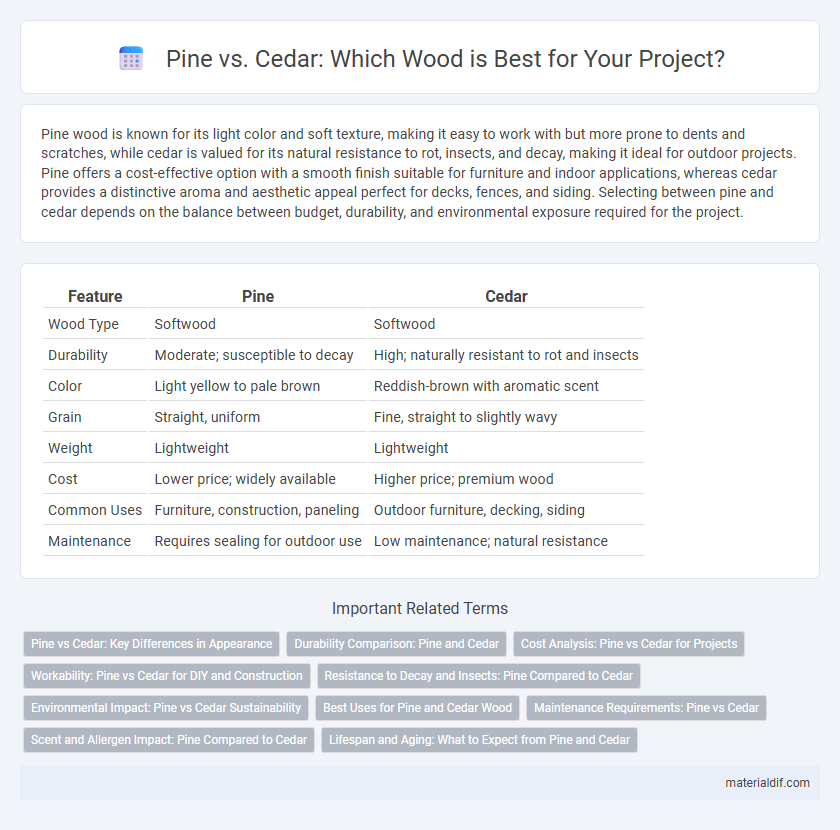Pine wood is known for its light color and soft texture, making it easy to work with but more prone to dents and scratches, while cedar is valued for its natural resistance to rot, insects, and decay, making it ideal for outdoor projects. Pine offers a cost-effective option with a smooth finish suitable for furniture and indoor applications, whereas cedar provides a distinctive aroma and aesthetic appeal perfect for decks, fences, and siding. Selecting between pine and cedar depends on the balance between budget, durability, and environmental exposure required for the project.
Table of Comparison
| Feature | Pine | Cedar |
|---|---|---|
| Wood Type | Softwood | Softwood |
| Durability | Moderate; susceptible to decay | High; naturally resistant to rot and insects |
| Color | Light yellow to pale brown | Reddish-brown with aromatic scent |
| Grain | Straight, uniform | Fine, straight to slightly wavy |
| Weight | Lightweight | Lightweight |
| Cost | Lower price; widely available | Higher price; premium wood |
| Common Uses | Furniture, construction, paneling | Outdoor furniture, decking, siding |
| Maintenance | Requires sealing for outdoor use | Low maintenance; natural resistance |
Pine vs Cedar: Key Differences in Appearance
Pine wood typically exhibits a pale yellow hue with prominent knots and a straight grain pattern, while cedar showcases a richer reddish-brown color with a finer, more uniform texture. Pine's lighter color and visible resin pockets contrast with cedar's natural oils that give it a smooth, aromatic finish resistant to decay. These distinctive visual characteristics make pine suitable for bright, rustic designs and cedar ideal for elegant, durable outdoor applications.
Durability Comparison: Pine and Cedar
Cedar wood boasts superior durability compared to pine due to its natural oils and resin content that resist rot, decay, and insect damage. Pine is more prone to wear and requires regular treatment to maintain longevity, especially in outdoor applications. For outdoor furniture and siding, cedar offers a longer lifespan and better resistance to harsh weather conditions than pine.
Cost Analysis: Pine vs Cedar for Projects
Pine typically costs less than cedar, making it a budget-friendly choice for large-scale projects or those with tight financial constraints. Cedar, while more expensive, offers superior natural resistance to decay and insects, potentially reducing long-term maintenance expenses. Project owners must weigh initial material costs against durability factors when choosing between pine and cedar.
Workability: Pine vs Cedar for DIY and Construction
Pine offers excellent workability due to its softness, making it easy to cut, shape, and sand for DIY projects and construction. Cedar, while slightly harder, provides natural resistance to decay and insects, enhancing durability in outdoor applications but requiring more effort in handling. Both woods are favored for their distinct qualities, with pine preferred for interior work and cedar commonly used in exterior and specialty projects.
Resistance to Decay and Insects: Pine Compared to Cedar
Cedar wood exhibits superior resistance to decay and insects due to its natural oils and preservatives, making it ideal for outdoor projects. Pine, while more affordable and widely available, is more susceptible to rot and insect damage unless treated with chemical preservatives. Selecting cedar over pine enhances durability and reduces maintenance in environments prone to moisture and pests.
Environmental Impact: Pine vs Cedar Sustainability
Pine wood is generally considered more sustainable due to its faster growth rate and greater availability, making it a renewable resource with a lower environmental impact. Cedar grows slower but contains natural oils that resist decay and insects, reducing the need for chemical treatments and extending the wood's lifespan. Choosing pine or cedar involves balancing growth rate and durability, with pine offering quicker replenishment and cedar providing longer-lasting, low-maintenance options that benefit environmental sustainability.
Best Uses for Pine and Cedar Wood
Pine wood is best suited for indoor furniture, flooring, and paneling due to its affordability, lightweight nature, and ease of staining or painting. Cedar wood excels in outdoor applications like decking, fencing, and garden furniture because of its natural resistance to rot, insects, and moisture. Both woods offer distinct advantages: pine for cost-effective, versatile interior projects; cedar for durable, weather-resistant exterior installations.
Maintenance Requirements: Pine vs Cedar
Maintenance requirements for pine wood include regular sealing or staining to prevent moisture damage and insect infestation, as pine is more porous and prone to decay. Cedar wood naturally resists rot, insects, and weathering due to its high concentration of natural oils and resins, requiring less frequent maintenance and no chemical treatments. Pine demands more consistent upkeep in humid or wet climates, whereas cedar's inherent durability makes it ideal for low-maintenance outdoor applications.
Scent and Allergen Impact: Pine Compared to Cedar
Pine wood emits a fresh, resinous scent known for its uplifting and invigorating aroma, whereas cedar produces a rich, sweet, and woody fragrance that is often associated with natural insect-repelling properties. Pine's scent can sometimes trigger allergic reactions in sensitive individuals due to its higher resin content and volatile organic compounds (VOCs), while cedar is generally considered hypoallergenic and less likely to cause respiratory irritation. Understanding these differences helps consumers choose wood based on desired scent strength and allergen impact, optimizing indoor air quality and comfort.
Lifespan and Aging: What to Expect from Pine and Cedar
Pine typically has a shorter lifespan, averaging 10 to 15 years outdoors due to its softer wood and susceptibility to decay and insect damage. Cedar boasts a longer lifespan of 20 to 30 years or more because of its natural oils that resist rot, insects, and weathering. Over time, pine ages to a yellowish tone and can warp or crack, while cedar weathers gracefully, developing a silvery-gray patina without significant structural decline.
Pine vs Cedar Infographic

 materialdif.com
materialdif.com